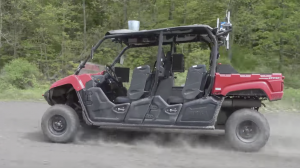
Yamaha Viking VI with autonomous driving technology.
Driverless technology and autonomous driving have been garnering plenty of attention and press lately. The vast majority of the focus has been on highway capable vehicles, but the small, task-oriented vehicle market (STOV) is active in this new area of innovation as well.
One recent example is Yamaha’s development of a fully autonomous Viking VI utility vehicle using their Autonomous System X1 technology. The screenshots from a video of the vehicle in action provides an idea of the technology at work.

No driver but some additional screens.

Some of the imagery tech the autonomous Viking VI uses.

The autonomous Viking VI maneuvering around an obstacle on the trail.
The system combines GPS, LIDAR (light detection and ranging) and an IMU (Inertial Measurement Unit). Publicly available aerial imagery and digital elevation maps are used to plan the trip, and simulations from a terrain model are used to find the best local path. In addition, camera images are used to detect traversable ares in an off-road environment. The video of the Viking VI in autonomous action is impressive.

GEM configured by MAy Mobility for self-driving.
Another example are two GEM vehicles being used by May Mobility to test self-driving technology in the city of Detroit. The testing will be conducted from Oct. 9 to 13 in conjunction with Bedrock, LLC, a real estate firm. The six seater GEMs are configured with May Mobility’s software and sensors and be used to transport Bedrock workers to and from various company locations. The vehicles will operate for three hours a day, travel only on roads with a speed limit of 35 mph or less, and have a driver on board to take control in emergency situations if necessary. Learn more: Startribune.com
In our recently released STOV market study, SVR argues that self-driving technology could produce a significant boost to the STOV market in the coming years. The lower speed environments may provide a safer environment to initially implement self-driving technology. A number of self-driving test vehicles are being used as shuttles along readily defined loops with limited variation. Gated communities are another low speed environment with limited variability that could provide an easier entry point. The largest potential though resides in a large scale movement towards new urban mobility platforms. In congested urban areas the speed limitations of LSVs are less critical as is the lower vehicle range. On the plus side is the smaller size, zero emissions and lower noise of the vehicles. Self-driving technology has the potential to facilitate large scale deployment of low speed vehicles in urban environments.
